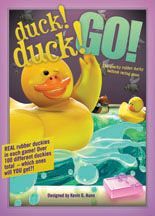I don’t know about you, but any game that lets me race a rubber duck across a chaotic bathtub has my attention. This is my review of duck! duck! go!—a game that’s as silly as it sounds and just as quacky. After a weekend of frantic paddling with friends (and more than one quack-related pun), I’ve got a lot to say about what’s fun, what’s bonkers, and what might make you want to toss this one back in the tub. Grab your floaties—let’s see if chasing bread crumbs and bumping beaks adds up to a good time!
How It Plays
Setting up
Put the pond tiles together in the middle of the table. Hand each player a cute duck, three paddle cards, and a matching player marker. Place the bread marker in the middle of the pond. Everyone picks a starting spot around the edge. Try not to quack too loudly.
Gameplay
On your turn, you pick one paddle card to play and secretly put it face down. Everyone does this at the same time. Then reveal cards together. Ducks move, turn, and try not to run into each other like confused bath toys. If your duck bumps into another duck or the pond edge, you spin out and have to start over. Grab bread by gliding over it, but watch out: other players can totally mess with your plans, sometimes by accident and sometimes because they’re jerks. Rounds go by fast, and the board gets silly in no time.
Winning the game
If your duck manages to collect the bread and then escapes off the edge of the pond, you win. Be warned: nothing is safe, and even a well-planned waddle can end in chaos. First to snatch the bread and make it out alive is crowned the paddle champion!
Want to know more? Read our extensive strategy guide for duck! duck! Go!.
Quacking Mad: How Duck! Duck! Go! Gets Players Flapping
Duck! Duck! Go! is not your grandma’s pond-based board game. Here, you and up to five friends each control a rubber ducky, each as determined as the next to speed around the pond and cross the finish line first. I brought it out at game night and my friends laughed at the idea…until someone got rammed into a lily pad and took it personally.
The core mechanic is program movement. You don’t just move your duck willy-nilly. Nope, you secretly pick three movement cards at the start of your turn, in order, and hope that by the time your third card hits, you haven’t landed on a rock or someone’s tail. Last time I played, my plan went from genius to disaster in literal seconds. Honestly, my duck did donuts while my friend’s duck hit warp-speed by accident. The movement system is simple, but it leads to brilliant chaos since you’re always trying to predict what slapstick move your rivals might pull.
The best part? You can deliberately bump into others’ ducks to knock them off course. This is the player interaction heart of the game. It’s silly, unpredictable, and sometimes cruel if you’re the one being punted. But there’s a sort of joy in both causing and receiving watery mayhem. There’s no point turtling up, because the pond is only so big and everyone’s out to win. It gets loud, competitive, and very, very funny.
Now, before I waddle away, let’s talk about whether skill or luck steers your duck to victory—coming up next time in my epic bread crumb trail of reviews!
Luck Versus Skill: Who’s Quacking Up?
Alright, let’s talk about the great debate: luck versus skill in duck! duck! go!. Now, I’ve played this game enough to know that it likes to sneak up and bite you in the waddle when you least expect it. Every round, you have to pick three movement cards and hope your little bathtub ducky doesn’t end up stuck behind someone else’s tail feathers. Thought you had the perfect plan? Oops, someone bumps you and suddenly you’re headed straight for a rubber duck traffic jam.
Here’s the honest truth: this game relies more on luck than a goose at a bingo hall. Sure, you can try to plan ahead, but unless you’ve got psychic powers, there’s just no way to know where everyone else will paddle. There’s definitely some strategy in picking your cards and watching your opponents, but I’ll be real: a well-timed random move from another player can ruin your whole strategy faster than you can say “quack attack.”
If you love games where outsmarting your pals earns you a win, you might feel a bit let down here. On the other hand, if you enjoy hilarious chaos and surprise victories, you’ll have a blast. For me, the swingy nature puts duck! duck! go! on the lighter end—fun, but not for the hyper-competitive. I would’ve loved a bit more control so the winner feels a bit more earned.
But don’t waddle away just yet! Up next, I’ll talk about how fabulous (or not) those little ducks and cards look on your table!
Is duck! duck! go! a Quacking Good Looker? Let’s Check the Bits!
Let me tell you, duck! duck! go! knows what it’s doing with its box and boards. We popped open the box and found these chunky rubber duckies staring back at us like they wanted to be on a bath-time yacht. The ducks are not just tokens; they’re chonky, bright, and easily the stars of your table. I named mine Sir Quacksworth, and yes, he did win—and he looked good doing it.
The board is, well, a simple pond, but the art is bright, cheery, and the kind a kid would draw if you asked them about ducks with jobs. The lily pads look a bit like green potato chips, but they’re thick enough to survive a spilled drink and some frantic duck-flinging. The cards are nothing to write home about, but they hold up to shuffling and even resisted the greasy fingers of my snack-loving friend, Big Mike.
One thing to know: if you love miniatures or intricate design, this isn’t your show. Everything is simple and cartoony, but it fits the mood. The insert, on the other hand, is about as useful as a lifejacket on a rubber duck. Components will bounce around, so baggies or rubber bands are your best friends here.
Bottom line: duck! duck! go! is cute, clean, and functional. Not museum art, but it looks fantastic mid-chaos! Next up, I’ll tell you just how many times we could not stop playing—and laughing—so get your giggle beaks ready for Fun factor and replay value!
Is duck! duck! go! Still Fun After a Few Races?
My friends and I lined up our plastic ducks and got ready to race. The table filled with cheers, quacks, and the occasional duck-related pun. The fun in duck! duck! go! is real. You never know if your duck will take the lead or spin straight into a pond tile—so every game night starts with giggles and ends with stories about doomed ducks and accidental victories.
The best part? It’s a breeze to learn. I taught my cousin, three neighbours, and even my grumpy uncle in less time than it takes to boil an egg. That means it’s easy to get fresh faces at the table. But after racing around the pond four or five times, some of my friends started looking at their phones. Why? The randomness that made us laugh early on can get old if you want more strategy. There are no hidden secrets to uncover or clever combos to master. After you’ve seen one duck ricochet off the edge, you’ve kind of seen them all. I wish there were extra cards or maps to shake it up, but nope, it’s the same basic pond every time.
Despite that, it’s a blast for families or groups who want a silly, low-stress laugh. If you’re looking for a game night starter or want a break from thinky games, duck! duck! go! is a solid pickup. However, if you want rich tactics or deep replay, your duck may need to find another pond. Would I recommend it? For a quick, social race with lots of laughter—absolutely!
Conclusion
If you want a game full of laughs, silly moments, and plastic duckies, duck! duck! go! checks those boxes. It’s easy to teach, quick to play, and brings out the chaos in any group. But if you crave deep strategy or hate leaving your fate to luck, this game won’t win you over. For families or friends who just want to splash around and see who gets their duck to the bread first, it’s a quacking good time. That’s it for my review—now if you’ll excuse me, I have a sudden craving for breadcrumbs and a rematch!


